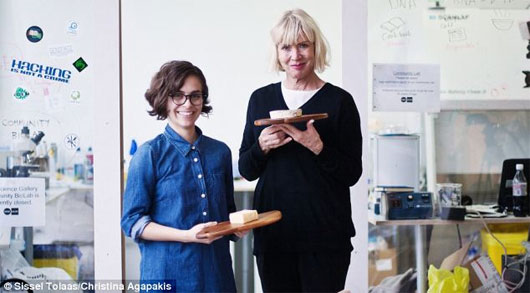Homemade cheese from bacteria in ... armpits, human legs
Scientists have found a way to process cheese from the bacteria that inhabit the legs, navel and even in the armpit of a person.
>>>Video: Homemade cheese from bacteria on human feet
Scientist Christina Agapakis and scent expert Sissel Tolaas collected bacteria for the project, called their "Selfmade" . Tolaas revealed on her website: "Selfmade is a series of" sketches or portraits "with bacteria that reflect the microbiological characteristics of each individual in a unique piece of cheese."

Photo: Daily Mail
Each of the special cheeses mentioned above was created to reflect the typical flavor of the person who provided the "ingredients" for processing it. Like the owner's body, each piece of cheese contains a unique microbial system, creating its own characteristic smell.
The invention team revealed, each cheesecake was born thanks to a set of bacteria extracted from the skin of artists, scientists, anthropologists and cheese makers. Microbial "material" samples are taken from human tears, legs, navel and even armpits with sterile cotton rags.
The researchers recorded a short film explaining this novel cheese processing and interviews with those who donated the bacteria. They recently displayed 11 cheeses of this type at an exhibition of artificial biology in Dublin, Ireland.
The inventor group claims that bacterial cheese is born not to eat, but instead: "evoke new debates about our relationship with our own bodies and microbes" .
- 3,200 year cheese contains deadly bacteria in Egyptian tombs
- Why do cheese have holes?
- Believe it, this color of cheese turns out to be a
- Electricity production from cheese, serving 1500 people
- Dangerous health threat when using homemade cold fans
- Homemade cheeses for 340 years under the Baltic Sea
- Why do some types of cheeses smell so badly?
- Exotic delicious cheese made from coal
- Nobody knows how English people produce fat cheese
- The 'amazing' world of bacteria in the human body
- Amazing journey from cow's milk to the world's most addictive food!
- The discovery caused a stir in a microbial system that lives right in the human brain
 Green tea cleans teeth better than mouthwash?
Green tea cleans teeth better than mouthwash? Death kiss: This is why you should not let anyone kiss your baby's lips
Death kiss: This is why you should not let anyone kiss your baby's lips What is salmonellosis?
What is salmonellosis? Caution should be exercised when using aloe vera through eating and drinking
Caution should be exercised when using aloe vera through eating and drinking